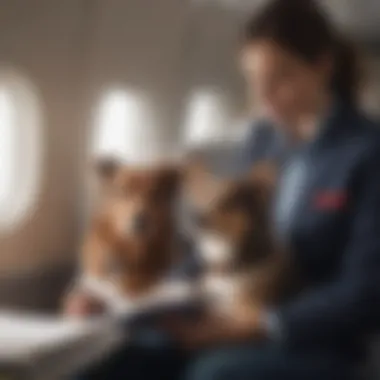Essential Guidelines for Traveling with Your Dog by Plane


Intro
Traveling with your dog by plane can seem overwhelming at first. Many pet owners have to navigate through various considerations. The goal of this guide is to provide key insights into flying with your dog. By understanding the necessary preparations and regulations, you can ensure a smooth journey for both you and your pet.
The significance of this topic cannot be overstated. With more people opting to travel with their pets, familiarity with airline policies is more critical than ever. Knowing what documentation is needed and how to prepare your dog for the trip makes a big difference.
This guide will take a closer look at the coverage options, key considerations, and practical tips to enhance the experience.
Coverage Options
When planning to travel with your dog, one key aspect to consider is insurance coverage. Understanding your options will give you peace of mind when embarking on your journey.
Types of Coverage Available
Different types of insurance coverages may be relevant for pet owners:
- Pet Travel Insurance: Cover medical emergencies while traveling.
- Liability Insurance: Protect against damages or injuries caused by your dog.
Each type of coverage has its own merits, depending on individual needs and circumstances.
Liability Coverage Explained
Liability coverage is essential for situations where your dog may cause an accidental injury or damage. This coverage will protect you from financial repercussions resulting from such incidents. Not all policies are the same, so it's vital to read through the terms and ensure that your pet is adequately covered.
Key Considerations
Before taking your dog on a flight, several factors must be assessed to ensure a successful trip.
Factors to Assess When Choosing Insurance
When selecting a pet insurance plan, consider the following factors:
- Coverage limits
- Deductibles
- Exclusions
Understanding these factors helps you choose the best plan for your situation. Different companies offer varying degrees of coverage, so researching before making a choice is essential.
Understanding Policy Limits
Every insurance policy comes with limits. These limits dictate not just how much you can claim but also what situations are covered. Knowing these details in advance can save you a great deal of trouble during your trip. It's best to clarify all terms with your insurance provider before flying.
"Preparation is key to ensuring a smooth travel experience with your dog. Understanding policies and coverage options minimizes potential issues while on the go."
To conclude, traveling with your dog can be a rewarding experience when planned well. Armed with the right information and policy coverage, pet owners can focus on making lasting memories with their furry companions.
Understanding Airline Policies
Traveling with a dog by plane requires a thorough understanding of various airline policies. Each airline has its unique set of rules and regulations. Knowing these details is essential for a smooth travel experience. Moreover, it helps avoid last-minute surprises at the airport.
Understanding airline policies on pet travel includes looking into the services offered, how to book tickets, and the conditions under which pets can travel. This knowledge can benefit both the owner and the pet, ensuring that the journey is as comfortable as possible.
Study the fine print in the policies of the airline you choose. This will reveal critical information about what to expect. Educating yourself means you can effectively prepare your pet for the journey.
Major Airlines and Their Policies
Not all airlines treat pet travel the same way. Some airlines are pet-friendly, allowing dogs in the cabin, while others only permit them as cargo. Here are a few airlines and a brief overview of their pet policies:
- Delta Airlines: Delta allows pets to travel in the cabin but has restrictions on breed and size for cargo. Health documentation is usually required.
- American Airlines: This airline permits small dogs in the cabin. However, specific breeds may be restricted altogether.
- United Airlines: Similar to other carriers, they allow in-cabin travel for small dogs. Cargo travel may be available for larger breeds but comes with a fee.


Always consult the airline's website directly for the most current information. Check if they have a dedicated pet travel section.
Pet Travel Fees
Airlines typically charge fees for pet travel, which are an essential consideration. These fees vary significantly between carriers. For example:
- Delta Airlines may charge around $125 for pet travel in the cabin.
- American Airlines tends to have a similar fee, about $125 for in-cabin pets.
It's important to budget for these costs when planning your trip. This can help prevent unexpected expenses.
Size and Breed Restrictions
Many airlines impose size and breed restrictions for dogs brought on board. Smaller breeds are often allowed to travel in the cabin, whereas larger dogs might be required to travel in cargo.
For instance:
- Brachycephalic breeds like Bulldogs or Pugs are often subject to strict regulations due to breathing issues. Airlines may not allow these breeds in the cabin or as cargo during extreme weather.
- Airlines usually define weight limits for in-cabin travel, often around 15-20 pounds.
Checking sizes and restrictions is crucial before traveling. Owners should confirm that their dog meets the requirements stipulated by the airline to avoid being turned away.
"Understanding your airline's pet policies can ensure a more pleasant travel experience for both you and your pouch."
Knowledge of airline policies simplifies the traveling process. It enhances your ability to navigate potential obstacles effectively.
Preparing for Air Travel
Traveling with your dog by plane demands significant planning and foresight. Many factors can influence the success of the journey. Taking time to properly prepare can mitigate stress for both you and your pet.
A well-thought-out approach includes multiple components that increase the chances of a smooth travel experience. From securing the necessary documentation to selecting a suitable carrier, each element plays a crucial role. This stage also helps to emotionally prepare your dog for the journey, which can ease anxieties.
Health Certificates and Documentation
One of the first steps in preparing for air travel is obtaining the necessary health certificates and documentation. Most airlines require a health certificate issued by a licensed veterinarian, typically issued within ten days before travel. This document confirms that your dog is in good health and up-to-date on vaccinations, ensuring compliance with airline regulations. Always check with the specific airline for their documentation needs as they can vary.
Additionally, some destinations may have strict entry requirements. For instance, traveling to Hawaii requires a rabies vaccination and potentially a rabies titer test. Research any specific requirements for your destination. Stay organized by creating a folder or digital file to store all relevant documentation, as you will need to present this at check-in.
Choosing the Right Carrier
Choosing the right carrier is paramount. Airlines have specific guidelines regarding size and type of carriers allowed. Generally, soft-sided carriers are preferred because they allow for some flexibility, which can lead to a more comfortable experience for your dog. Ensure that the carrier meets both the airline’s requirements and your dog's dimensions.
Look for carriers that offer proper ventilation and security features. It is important that your pet feels secure inside the carrier. Consider taking your dog for short practice runs in the carrier before the trip. This can help acclimate them to the environment and reduce anxiety.
Packing for Your Pet
Packing for your pet is as important as packing for yourself. Consider including essential items such as:
- Food and Water: Bring enough for the journey, as well as a portable bowl for easy access.
- Leash and Collar: Ensure your dog has a leash for airport navigation. Also, include an identification tag with your details.
- Comfort Items: Bring along a favorite toy or blanket. Familiar scents can provide comfort in a new environment.
By ensuring that you pack adequately, you make the trip less stressful for your pet. A focus on the small details can lead to a more enjoyable flying experience. Ultimately, the preparation phase is essential to successful air travel with your pet.
Cost Considerations
Understanding the financial implications of air travel with your dog is essential for any pet owner. This section explores various cost aspects, giving you clarity on what to expect and how to manage expenses effectively. Given that airline policies vary and additional fees can accumulate, being informed can lead to better budgeting and a smoother experience.
Airline Fees
Airline fees are an inevitable part of flying with your dog. It is crucial to know that each airline has its own pricing structure, which often hinges on factors like your dog's size, breed, and cabin placement. Some airlines charge a flat fee for pets traveling in the cabin, while others may have different fees for cargo shipments.
- Most carriers will charge you a fee ranging from $75 to $250.
- It may be cheaper for dogs under a certain weight, usually around 15 to 25 pounds, to fly with you in the cabin.
- Always check the specific airline's website or contact customer service as these fees often change.


Budgeting for these fees in advance can help avoid any financial surprises closer to your travel date.
Additional Costs
Traveling with a dog incurs further expenses beyond the airline fees. Here are common additional costs you may encounter.
Travel Insurance
Travel insurance provides a safety net by covering unexpected events, such as flight cancellations or illness of your pet. Policies vary widely.
- A key characteristic of travel insurance is its ability to offer peace of mind, particularly regarding the unforeseen health issues your pet might encounter during the trip.
- For many dog owners, it is a popular option because it can also cover costs related to urgent veterinary care incurred while traveling.
- However, it’s vital to read the fine print, as some policies might not cover pre-existing conditions, which can be a disadvantage.
Opting for travel insurance could ultimately save you from hefty out-of-pocket costs in a crisis.
Pet Sitters and Boarding
If your travel plans require an extended stay or your dog cannot accompany you, pet sitters or boarding facilities may be necessary.
- The main feature of hiring a pet sitter is the personalized care provided in your own home, which can create a less stressful environment for your pet.
- Conversely, boarding facilities can vary in quality and care options, which may make it a less favorable option for some owners.
- Another point to consider is the cost; pet sitters tend to be more expensive in certain areas, while boarding can be more economical but less personalized.
Ultimately, whether to choose a pet sitter or boarding depends on your dog's needs and your own budget considerations.
Cost-Saving Tips
There are several ways to save money when flying with your dog. Here are some strategies:
- Book Early: Airlines often have lower fees during off-peak seasons. Booking your travel in advance can lead to significant savings.
- Use Loyalty Programs: If you are a frequent flyer, consider using airline points to cover pet fees.
- Compare Airlines: Look at various airlines to find the best deal, as not all charge the same for pet travel.
- Pack Wisely: Bringing your own food and water will avoid the expense of buying them at the airport.
- Research Alternatives: Sometimes, driving may be a more economical option for shorter distances.
By being proactive and informed, you can significantly lower the costs associated with air travel for your pet.
During the Flight
Traveling with your dog by plane requires careful consideration during the actual flight. This section addresses crucial components that impact your dog's comfort and safety while airborne, as well as ways to reduce stress for both you and your pet.
Settling Your Dog in its Carrier
Before takeoff, it is vital to ensure your dog is comfortable in its carrier. This carrier should be familiar to your pet, as well as compliant with airline regulations. Place a soft bedding inside, possibly with a piece of your clothing to provide comfort. It is helpful if the carrier has adequate ventilation and is spacious enough for your dog to stand, turn around, and lie down.
Make sure your dog is secured properly. Airlines recommend using a carrier that can be closed securely and will not open unintentionally during transit. Keep your dog’s favorite toy or chew in the carrier to occupy it during the flight. Verify that your dog is calm before the flight, as a stressed pet is more likely to be disruptive.
Managing Anxiety
Dogs can experience significant anxiety during air travel. It is important to recognize the signs of anxiety in your pet such as whining, barking, or attempting to escape the carrier. Preparation is key to easing this anxiety. Consider utilizing anti-anxiety products such as calming collars or natural supplements like melatonin, but consult with your veterinarian first for appropriate dosages.
Creating a routine before and during the flight can help mitigate stress. Regular exercise before travel can reduce excess energy, making your dog more relaxed. When flying, it's essential to remain calm yourself, as dogs can pick up on your emotions. If possible, engage with your dog during the flight by speaking softly or using treats to reinforce positive behavior.
"Familiarity can be soothing: a cherished toy or item from home can help your pet feel secure during challenging moments."
Feeding and Hydration
Feeding your dog properly before the flight is crucial. A light meal a few hours before departure can help prevent motion sickness. Avoid feeding your dog immediately before flying as it might lead to discomfort. Bring along a portable water bowl for hydration. It is critical to keep your dog hydrated, especially on long flights.
Airlines may not provide water for pets, so plan ahead by giving your dog water before takeoff and during layovers. Some carriers come with water bowls that attach to the inside, making it easy for your dog to drink without spilling. During the flight, always monitor your dog for signs of dehydration, such as excessive panting or lethargy.
In summary, focusing on the settling processes, managing anxiety, and proper feeding and hydration makes the flight experience more manageable for you and your dog. Attention to these details can greatly enhance the comfort of your pet, allowing for a less stressful travel journey.
Post-Arrival Procedures
When traveling with your dog by plane, the journey does not end once you have landed. Post-arrival procedures are critical for ensuring your pet's wellbeing and a smooth transition into a new environment. Several important procedures need consideration, from adhering to airport regulations to understanding customs requirements and locating suitable accommodations. These elements not only affect compliance with legal standards but also contribute to your pet's comfort and safety.


Airport Regulations for Pets
Upon landing, it is essential to be aware of the airport regulations for pets that can vary significantly between locations. Many airports have specific areas designated for pet relief, allowing dogs to relieve themselves and stretch their legs after a long flight. Furthermore, you are likely to encounter rules regarding leash laws and pet containment. Before traveling, familiarize yourself with these regulations; doing so will significantly ease your transition through the airport.
- Designated Areas: Most airports have specific zones for pets to go potty. Check the airport website for details.
- Leash and Muzzle Policies: Different airports may have unique requirements regarding leashes or muzzles. Always have a muzzle ready, especially if your dog is anxious.
- Documentation Checks: Be prepared to show health certificates if requested by airport authorities. Ensuring you have all necessary paperwork can prevent delays.
"Ensuring compliance with airport regulations not only guarantees a smoother process but helps you focus on your pet’s needs right after landing."
Customs and Entry Requirements
If your travel involves crossing international borders, understanding customs and entry requirements for pets is vital. Different countries impose varied regulations on pet entry, including vaccination requirements and quarantine rules. Always check the requirements of your destination well in advance to ensure a hassle-free experience.
- Health Certificates: Most countries require a health certificate issued by a vet stating that your dog is fit for travel and up to date on vaccinations.
- Breed Restrictions: Some destinations have restrictions on specific breeds. Researching these beforehand can save time and avoid complications upon arrival.
- Quarantine Regulations: Be aware that some places may require your pet to stay in quarantine. Knowing this in advance helps you prepare both mentally and logistically.
Finding Pet-Friendly Accommodations
The final step in the post-arrival phase involves finding pet-friendly accommodations. It is essential to ensure that the place you intend to stay welcomes dogs and has amenities catering to their needs. Here are some strategies to secure pet-friendly lodging:
- Online Research: Websites like Expedia and Booking.com allow you to filter results for pet-friendly options.
- Directly Contact Hotels: Some places might not always advertise their pet policy online, so calling ahead can provide clarity.
- Amenities Check: Look for accommodations that provide pet beds, bowls, and nearby parks.
Taking these steps ensures your stay will be comfortable for both you and your dog. Knowing your pet’s needs enhances their travel experience and helps them adjust quickly to a new site.
Additional Considerations
Traveling with your dog can be delightful yet complex, especially when considering the nuances of international pet travel and managing multiple pets. These factors are critical for ensuring the safety, comfort, and well-being of your furry companions. Addressing these additional considerations may seem daunting, but being well-informed can significantly enhance the travel experience for both pet and owner.
Traveling Internationally with Pets
International travel with pets presents a unique set of challenges. Each country has different regulations regarding the importation of animals. It is vital to research the specific requirements of your destination well in advance. Health certificates, vaccinations, and sometimes even permits may be required, depending on where you are headed.
Here are some important steps to consider:
- Check Destination Requirements: Understand what diseases are prevalent in the destination country and which vaccinations are mandatory.
- Obtain Necessary Documentation: Most countries require a health certificate issued by a veterinarian shortly before travel.
- Plan for Quarantine Rules: Some regions may require your pet to undergo a quarantine period upon arrival, which can be stressful for both you and your pet.
Taking these precautions not only ensures compliance but also safeguards your pet's health and reduces the risk of last-minute surprises.
Traveling with Multiple Pets
Traveling with multiple pets can add layers of complexity to your journey. Each animal may have individual needs and may react differently to travel stress. Coordination is key in ensuring a smooth experience. Here are some points to keep in mind:
- Carrier Size and Comfort: Ensure that each pet has an appropriately sized carrier for comfort during the flight. Consider carriers that are easy to secure together for easier transport.
- Designate Roles: Assign one handler per pet if possible. This allows for focused attention and can help manage stress for both the animals and the humans involved.
- Pack for Each Pet: Bring enough supplies, including food, water, medications, and familiar items like toys or bedding for each pet. Familiar smells help to ease anxiety.
Traveling with multiple pets requires extra preparation and attention but can lead to a rewarding journey if managed well.
In summary, navigating international pet travel and managing multiple pets involves detailed planning and an understanding of regulations. Addressing these considerations will enhance the travel experience. Always prioritize your pets' well-being, and your journey may become a memorable adventure.
Epilogue
Traveling with your dog by plane encompasses a myriad of important factors that must be meticulously considered. The conclusion of this article aims to synthesize critical elements discussed throughout, emphasizing the need for thorough preparation and awareness of airline policies. Understanding these guidelines is not just a matter of convenience; it is essential for ensuring the safety and comfort of your pet during air travel.
Recap of Key Points
To sum up, several key points have emerged from our exploration:
- Airline Policies: Each airline has distinct regulations regarding pet travel. Familiarity with these policies will facilitate smoother travel.
- Preparation is Crucial: Gaining the necessary documentation such as health certificates and choosing the appropriate carrier are vital steps. Proper packing for your pet ensures they have what they need during the journey.
- Cost Considerations: Understanding fees related to air travel with pets and planning for any additional costs can prevent financial surprises.
- Post-Arrival Considerations: Awareness of customs and local regulations can save much stress upon arrival.
"Being prepared is the cornerstone of a successful journey with your dog by plane."
Final Recommendations
Based on the information presented, here are some final recommendations:
- Start Planning Early: Begin preparations well in advance. This includes securing documentation and making necessary arrangements.
- Research Thoroughly: Look into various airlines and their specific pet policies. You may find some that better suit your needs.
- Consult with a Veterinarian: Prior to traveling, a visit to the veterinarian can help ensure your pet is fit for the journey. This also allows for any last-minute health assessments.
- Stay Calm During Travel: Keeping a calm demeanor during the flight can help ease your pet’s anxiety. Be attentive to their needs and comfort.
By following these guidelines, pet owners can ensure their travels are as smooth and enjoyable as possible for both themselves and their canine companions.



